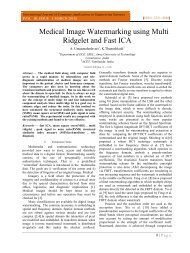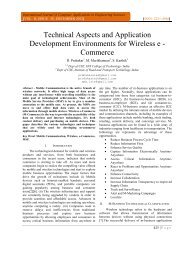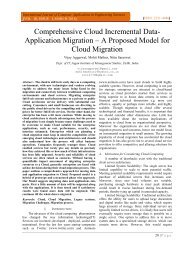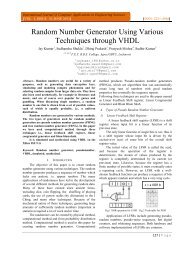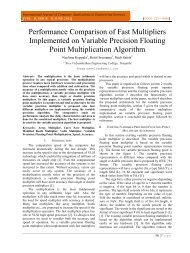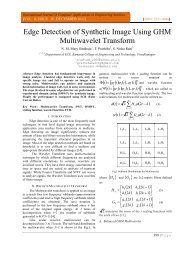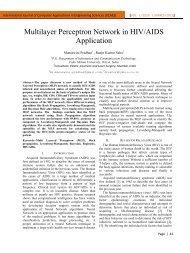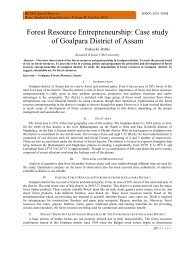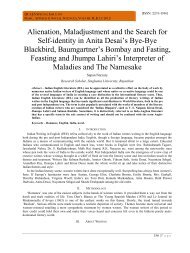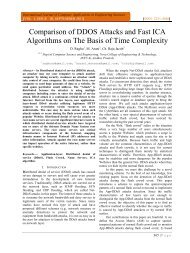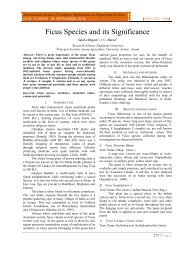Satellite Imagery Quality Evaluation using Image Quality Metrics for ...
Satellite Imagery Quality Evaluation using Image Quality Metrics for ...
Satellite Imagery Quality Evaluation using Image Quality Metrics for ...
Create successful ePaper yourself
Turn your PDF publications into a flip-book with our unique Google optimized e-Paper software.
International Journal of Computer Applications in Engineering Sciences<br />
[VOL I, SPECIAL ISSUE ON AISC , DECEMBER 2011] [ISSN: 2231-4946]<br />
<strong>Satellite</strong> <strong><strong>Image</strong>ry</strong> <strong>Quality</strong> <strong>Evaluation</strong> <strong>using</strong><br />
<strong>Image</strong> <strong>Quality</strong> <strong>Metrics</strong> <strong>for</strong> Quantitative<br />
Cadastral Analysis<br />
1 Usman Babawuro, 2 Zou Beiji<br />
School of In<strong>for</strong>mation Science and Engineering, Department of Computer Science, Central South University,<br />
Changsha, 410083, Hunan, PR China<br />
1 wuroabu@yahoo.com<br />
2 bejzou@vip.163.com<br />
Abstract— <strong>Satellite</strong> imageries are provided in both<br />
panchromatic and multispectral images. The <strong>for</strong>mer have<br />
higher spatial resolutions while the latter have relatively<br />
lower spatial resolutions but are rich in spectral<br />
in<strong>for</strong>mation. The two types of images have complementary<br />
features of spatial and spectral resolutions as such could be<br />
fused or merged to produce a better imagery that would be<br />
used in land use classification, cadastral feature analysis,<br />
change detection, maps updates, hazards monitoring and<br />
many other land related applications as well as <strong>for</strong> general<br />
quantitative image analysis. <strong>Image</strong> fusion quality<br />
evaluation approaches are divided into two main<br />
categories: qualitative and quantitative evaluation<br />
approaches. In qualitative approach, quantifying image<br />
quality is done through subjective means by human<br />
experts, whereas quantitative evaluation is based on<br />
objective per<strong>for</strong>mance assessments of the fusion processes.<br />
Registration of images that may be used as reference in<br />
image quality measure is a crucial step in <strong>Satellite</strong> image<br />
processing. Errors due to registration of reference images<br />
give rise to local errors in merging processes and these<br />
results in significant color and other distortions in the<br />
fused imagery. Be<strong>for</strong>e <strong>using</strong> the images in cadastral aspects<br />
of object extraction or recognition, the quality assessment<br />
of these image data is highly crucial and cannot be over<br />
emphasized. The paper attempts to measure the quality of<br />
high resolution multispectral images of a region that has a<br />
variety of artificial and natural patterns <strong>using</strong> some well<br />
known image quality assessment metrics or predefined<br />
quality indicators. Experimental comparisons, <strong>using</strong><br />
Matlab as a tool, between sets of noised and referenced<br />
images of different high resolution images, demonstrated<br />
the effectiveness of the proposed method. Finally, the<br />
necessary metrically good satellite images <strong>for</strong> further<br />
quantitative cadastral analysis were practically obtained.<br />
Keywords— <strong>Satellite</strong> <strong><strong>Image</strong>ry</strong>, <strong>Image</strong> Fusion, <strong>Quality</strong><br />
metrics, Cadastral Analysis, Spatial resolution<br />
I. INTRODUCTION<br />
With the successful launching of the new generation<br />
of satellite imaging systems, very high resolution<br />
Multispectral (MS) and Panchromatic (Pan) images are<br />
made available, to enhance the automation of vision<br />
tasks, and in some instances, act as replacements to the<br />
traditional aerial photographs [1]. The recent progress in<br />
<strong>Satellite</strong> imagery, in terms of higher spatial resolution<br />
and faster data processing, has opened up new<br />
possibilities regarding its use <strong>for</strong> quantitative and<br />
qualitative assessments. Using high resolution <strong>Satellite</strong><br />
imagery, an assessment of cadastral features could be<br />
per<strong>for</strong>med successfully. Based on the per<strong>for</strong>mance of<br />
GOES-8, future spacecraft in the GOES I–M series is<br />
providing many years of useful services to <strong>Image</strong><br />
Analysists, Meteorologists, Oceanographers, and the<br />
general environmental community [2]. <strong>Satellite</strong><br />
imageries are provided in both panchromatic and<br />
multispectral images. The <strong>for</strong>mer have higher spatial<br />
resolutions while the latter have lower spatial resolutions<br />
but are rich in spectral in<strong>for</strong>mation. The two types of<br />
images have to be fused or merged experimentally to<br />
produce some complementary characteristics of spatial<br />
and spectral resolutions so as to be used in land use<br />
classification, cadastral feature analysis, change<br />
detection, maps updates, hazards monitoring [10], [11],<br />
and many other land related applications as well as <strong>for</strong><br />
general quantitative analysis. Intensity–Hue–Saturation<br />
(IHS) based fusion methods, however, may introduce<br />
severe radiometric distortion, i.e., bias in local mean, in<br />
the sharpened MS bands, due to the low-pass component<br />
of the Pan image, which affects the fusion product [1].<br />
All the above methods are simply used in the case of<br />
exactly three spectral bands. When a larger number of<br />
components is concerned, e.g., <strong>for</strong> IKONOS-2 and<br />
QuickBird having four spectral bands, comprising Blue<br />
(B), Green (G), Red (R), and Near Infrared (NIR), IHS<br />
methods are applied to three bands at a time, whose<br />
fused image are displayed in color, either true or false.<br />
However, spectral distortion can be measured,<br />
regardless of the number of components, as the absolute<br />
angle between a pixel vector in the true and in the fused<br />
MS data. It is desirable that such an angle is lower than<br />
or equal to that measured between the resampled<br />
original low-resolution MS data and the true highresolution<br />
MS data, when available, as in fusion carried<br />
out on spatially degraded images. When the angles are<br />
391 | P a g e
Babawuro et. al.<br />
equal means that the fusion algorithm has thoroughly<br />
preserved the available spectral in<strong>for</strong>mation and also<br />
obtained the obvious benefits of spatial enhancement<br />
[1]. Measurement of image quality is a challenging<br />
problem in many fields of <strong>Image</strong> Processing [4]. It is of<br />
fundamental Importance to numerous image and video<br />
processing applications [13]. In the past years, a vast<br />
literature has appeared with many approaches<br />
attempting to provide solutions [12]. The goal of image<br />
quality assessment (IQA), is to design algorithms that<br />
can automatically assess the quality of images or videos<br />
in a perceptually consistent manner [13]. The most<br />
widely used full-reference image quality and distortion<br />
assessment algorithms are peak signal-to-noise ratio<br />
(PSNR) and mean squared error (MSE), which do not<br />
correlate well with perceived quality [4],[12]. MSE is<br />
also not good because the residual image is not<br />
uncorrelated additive noise and it contains components<br />
of the original image[12]. IQA of Pan-sharpened MS<br />
images is not an easy task [1]. Even when spatially<br />
degraded MS images are processed <strong>for</strong> Pan-sharpening,<br />
and there<strong>for</strong>e reference MS images are available <strong>for</strong><br />
comparisons, assessment of quality, or more exactly of<br />
fidelity to reference, usually requires computation of a<br />
number of different score indices. Examples are<br />
Correlation Coefficient (CC) between each band of the<br />
fused and reference MS images, bias in the Mean, Root<br />
Mean Square Error (RMSE), and Spectral Angle<br />
Mapper (SAM), which measures the spectral distortions<br />
introduced by the fusion process [1]. IQA of different<br />
image fusion schemes are traditionally carried out by<br />
subjective evaluations. <strong>Image</strong> quality evaluation goal<br />
coincides with the subjective image quality assessment<br />
(SIQA) of an image, as the subjective mean opinion<br />
score of the image quality follows human visual<br />
perception [8] as such it is tedious, expensive and cannot<br />
be conducted in real time [12]. In addition to the stated<br />
demerits, SIQA is not only difficult to reproduce and<br />
verify, but it is also difficult to embed into the image<br />
fusion algorithms to optimize some parameters, hence<br />
the need <strong>for</strong> objective image fusion per<strong>for</strong>mance metrics<br />
that are consistent with human visual perception [3], [8],<br />
[12] so as to get the most metrically optimum images <strong>for</strong><br />
certain quantitative image analysis. Objective image<br />
quality assessment (OIQA) research aims at designing<br />
quality measures that can automatically predict the<br />
perceived traditional image quality [6]. These quality<br />
measures play important roles in a broad range of<br />
applications such as image acquisition, compression,<br />
communication, restoration, enhancement, feature<br />
extration, analysis, display, printing and watermarking<br />
[6]. OIQA is generally classified into two approaches:<br />
Perceptual and Structural in<strong>for</strong>mation based and the<br />
closer it is to the SIQA, the better the metrics [8], [6].<br />
However, there is no current standard and objective<br />
definition of image quality as such the field is still open<br />
<strong>for</strong> rigorous reseach [7]. After spatial enhancement of<br />
satellite imagery, preservation of spectral in<strong>for</strong>mation<br />
regarded as differences among spectral bands, or<br />
equivalently as color hues in the composite<br />
representation of three bands at a time should be<br />
guaranteed. So, the procedures developed have often<br />
been based on the trans<strong>for</strong>mation of spectral bands,<br />
resampled at the scale of Pan, into Intensity–Hue–<br />
Saturation (IHS) coordinates, replacement of the smooth<br />
Intensity component with the sharp Pan; and then<br />
getting the inverse trans<strong>for</strong>mation to yield the fusion<br />
product. <strong>Image</strong> fusion quality evaluation approaches are<br />
divided into two main categories: qualitative and<br />
quantitative [4] evaluation approaches. In qualitative<br />
approach, quantifying image quality is done through<br />
subjective means by human experts, whereas<br />
quantitative evaluation is based on objective<br />
per<strong>for</strong>mance assessment of the fusion processes.<br />
Registration of images that may be used as reference in<br />
image quality measure is a crucial step in <strong>Satellite</strong> image<br />
processing [9]. Specific examples of systems where<br />
image registration is a necessity include matching a<br />
target with a real-time image of a scene <strong>for</strong> target<br />
recognition, monitoring global land usage <strong>using</strong> satellite<br />
images, matching stereo images to recover shape <strong>for</strong><br />
autonomous navigation, and aligning images from<br />
different devices <strong>for</strong> various analysis [9]. Errors due to<br />
registration of reference images give rise to local errors<br />
in merging processes and these results in significant<br />
color and other distortions in the fused imagery. Be<strong>for</strong>e<br />
<strong>using</strong> the images in cadastral aspects of object extraction<br />
or recognition, the quality assessment of these image<br />
data is highly crucial and cannot be over emphasized.<br />
Because of the inherent drawbacks associated with<br />
subjective measures of image quality, there has been a<br />
great deal of interest in developing quantitative<br />
measures, either in numerical or graphical <strong>for</strong>ms, that<br />
could be consistently used as substitutes [5], [8]. The<br />
measure is not only to judge image quality but also <strong>for</strong><br />
quality judgment across various algorithms. This latter<br />
part is definitely more challenging compared to the<br />
<strong>for</strong>mer. It is known that Mean Square Error (MSE), the<br />
most common objective criteria, or its variants do not<br />
correlate well with subjective quality measures [5]. In<br />
this paper, objective image quality metrics <strong>for</strong> MS<br />
images having three spectral bands are applied to the<br />
Pan-sharpened MS images produced <strong>using</strong> Erdas<br />
Imagine. We experimentally applied some algorithms<br />
<strong>for</strong> image quality assessments to two categories of<br />
multispetral satellite imageries.One category contained<br />
the original images while the other contained noised<br />
images of the first category so as to assess quantitatively<br />
their metric quality values <strong>using</strong> Matlab as a tool. In the<br />
end, we then assessed the capabilities of the image<br />
392 | P a g e
<strong>Satellite</strong> <strong><strong>Image</strong>ry</strong> <strong>Quality</strong> <strong>Evaluation</strong> <strong>using</strong> <strong>Image</strong> <strong>Quality</strong> <strong>Metrics</strong> <strong>for</strong> Quantitative Cadastral Analysis<br />
metrics with respect to the images used. Knowlegdge<br />
and per<strong>for</strong>mances of the metrics enabled us to<br />
understand the qualities of the images <strong>for</strong> future<br />
quantitative cadastral analysis. The images with the best<br />
or most optimum quality metrics are to be used <strong>for</strong> such<br />
analysis. The rest of the paper is organised as follows:<br />
Section 2, covers the related work. Section 3, gives<br />
highlight on the image fusion quality assessments.<br />
Section 4, handles the implementation. Section 5, is the<br />
results of the experiments, while Section 6, contains the<br />
conclusion.<br />
II. RELATED WORK<br />
Measurement of image quality is a challenging<br />
problem in many image processing fields from image<br />
compression to printing [4]. Earlier works by [5],<br />
described image quality vis-vis different compression<br />
techniques, and [4] used Singular Value Decomposition<br />
approach to measure locally and globaly the quality of a<br />
gray scale image. Reference [1] focuses on quality<br />
assessment of fusion of multispectral (MS) images with<br />
high-resolution panchromatic (Pan) observations. Using<br />
the theory of hypercomplex numbers, or quaternions,<br />
they defined new quality index suitable <strong>for</strong> MS imagery<br />
having four spectral bands. Reference [6], proposed a<br />
multi-scale structural similarity approach <strong>for</strong> image<br />
quality assessment, which provides more flexibility than<br />
single scale approach in incorporating the variations of<br />
image resolution and viewing conditions. One of the<br />
shortcomings of structural similarities measure index,<br />
(SSIM), index algorithm is that it is a single scale<br />
approach [6]. As contained in [6], the authors ended up<br />
by introducing a novel image synthesis-based approach<br />
to calibrate the parameters that weigh the relative<br />
importance between different scales in trying to<br />
determing the quality of an image. Reference [3],<br />
presented a novel objective quality metric <strong>for</strong> the<br />
evaluation of image fusion schemes where special<br />
interest of the metric lies in the fact that the redundant<br />
regions and the complementary/conflicting regions are<br />
treated respectively according to the structural similarity<br />
between the source images. <strong>Image</strong> quality measure<br />
based on Discrete wavelet trans<strong>for</strong>m (DWT) sub-band<br />
decomposition properties which are similar to human<br />
visual system characteristics facilitate the integration of<br />
DWT into image-quality evaluation as presented by<br />
[7]. Reference [8] approached the method from a<br />
different perspective. Since evaluating the quality of an<br />
image is equivalent to measuring the degree of<br />
de<strong>for</strong>mation of the structure of the image, they proposed<br />
a new image quality metric based on the Harris<br />
response, which is computed from the gradient<br />
in<strong>for</strong>mation matrix and its eigenvalues. Reference [12],<br />
presented detailed survey review of image and video<br />
quality assessment algorithms, <strong>for</strong> the metric quality<br />
assessment of such compressed images and videos.<br />
III. IMAGE QUALITY MEASURE<br />
In general, the qualititative evaluation approach <strong>for</strong><br />
image fusion quality is a time consuming process and<br />
needs expert operators [3]. There<strong>for</strong>e, there is a wide<br />
range of research in the direction of the quantitative<br />
evaluation which is based on objective per<strong>for</strong>mance<br />
assessment of fusion process. A quantitative approach<br />
should measure the ability of fusion process to transfer<br />
all perceptually important in<strong>for</strong>mation of input images<br />
into the output image as accurately as possible.<br />
However, quantitative per<strong>for</strong>mance assessment is a<br />
difficult issue due to the variety of different<br />
requirements and the lack of a clearly defined groundtruth.<br />
A wide range of quantitative fusion assessment<br />
techniques are based on the initial concepts of image<br />
quality metrics such as Entropy, Universal <strong>Quality</strong> Index<br />
(UQI) and Correlation Coofficient (CC), which are<br />
already used to compare quality of two different images<br />
in image processing applications. Measures that require<br />
both the original (reference) image and the distorted<br />
image are called ―full-reference‖ methods while those<br />
that do not require the original image are called ―noreference‖<br />
methods. The quality measures included in<br />
our evaluation are all discrete and bivariate, e.g, they<br />
provide some measure of closenss between two digital<br />
images by exploiting the differences in the statistical<br />
distributions of pixel values. F(j,k) and f(j,k), could<br />
denote the samples of original and degraded image<br />
fields. One of the most commonly used quantitative<br />
measure metric is SSIM which uses the structural<br />
in<strong>for</strong>mation <strong>for</strong> evaluating the image quality. Structural<br />
in<strong>for</strong>mation used in SSIM consists of three components<br />
such as luminance, contrast, and structure comparison<br />
functions [8]. SSIM <strong>for</strong> the corresponding regions in a<br />
reference original signal x and the test image signal, y is<br />
as defined in equation (i) as contained in [3], [8].<br />
SSIM(x,y|w) =<br />
(2 w w C )(2 C<br />
)<br />
x y 1 w w 2<br />
x y<br />
2 2<br />
2 2<br />
x y <br />
1<br />
w <br />
x w<br />
<br />
y 2<br />
( w w C )( C )<br />
which is decomposed as shown in (ii),<br />
SSIM(x,y|w) =<br />
(2 w w C )(2 C )( C )<br />
x y 1 wxwy 2 wxwy<br />
3<br />
2 2<br />
2 2<br />
x y <br />
1<br />
<br />
wx<br />
wy<br />
<br />
2<br />
<br />
wx<br />
wy<br />
<br />
3<br />
( w w C )( C )( C )<br />
(ii)<br />
where C 1 , C 2 and C 3 are small constants,<br />
with C 3 = C 2 /2, wx denotes the sliding window or the<br />
region under consideration in x, is the mean<br />
(i)<br />
393 | P a g e
Babawuro et. al.<br />
of w x , and σ wxwy are the variance of w x and<br />
covariance of w x and w y , respectively. The value<br />
SSIM(x, y∣ w) is a measure <strong>for</strong> the similarity between<br />
the regions w x and w y . If SSIM is close to one, the<br />
distorted image is similar to the reference image. Its<br />
dynamic range is [−1, 1] and the best value of 1 is<br />
achieved if and only if w x and w y are the same.<br />
IV. IMPLEMENTATION<br />
The proposed quality index is evaluated by <strong>using</strong> very<br />
high resolution multispectral Quick Bird <strong>Satellite</strong><br />
<strong><strong>Image</strong>ry</strong> data comprising of four bands with 2.4 m<br />
(7 ft 10 in) resolution acquired in 2005 over a relatively<br />
flat landscape at Changsha City, Hunan Province in the<br />
South Central region of PR China. From this, a set of<br />
true color imageries are fused and synthesied <strong>for</strong> the<br />
analysis. Then another set of noised images of the same<br />
<strong>for</strong>mat to tamper with their structural characteristics and<br />
size are as well obtained, as image degradation de<strong>for</strong>ms<br />
the structure of an image [8]. In the experiments,<br />
classical image quality parameters were computed,<br />
analysed and visual comparisons of the images done and<br />
recorded. The purpose of taking the mentioned<br />
paramenters is to assess the reliability and the<br />
completeness of this method of image metric<br />
per<strong>for</strong>mance evaluation <strong>for</strong> images so as to metrically<br />
assess their qualities <strong>for</strong> further quantitative cadastral<br />
analysis. Thus, in our experiments, we employed sets of<br />
original 365x286 satellite images with different types of<br />
content and also used corresponding sets of distorted<br />
images <strong>for</strong> the metric analysis. In Fig 1 and Fig 2, we<br />
show sample of the results.<br />
V. RESULT<br />
To carry out the image metric per<strong>for</strong>mance evaluation of<br />
the proposed approach, we have carried out sets of<br />
experiments comprising of the original and the<br />
corresponding distorted images. Hence, we tested a<br />
number of image quality assessment algorithms <strong>using</strong><br />
the given images so as to assess their impact metrically<br />
and to know the best images metrically <strong>for</strong> quantitative<br />
analysis. In the experiment, each image was subjected to<br />
test metricallly <strong>using</strong> the twelve metics of the listed<br />
image quality metric indices shown in Table 1.<br />
Table I Comparison between Different <strong>Quality</strong> Measures <strong>for</strong> the<br />
<strong>Image</strong>s<br />
Metrix<br />
Exp1<br />
(Set of<br />
<strong>Image</strong><br />
1)<br />
Exp2<br />
(Set of<br />
<strong>Image</strong> 2)<br />
Exp3<br />
(Set of<br />
<strong>Image</strong> 3)<br />
Exp4<br />
(Set of<br />
<strong>Image</strong> 4)<br />
SSIM 0.7642 0.7578 0.7511 0.7597<br />
PSNR 13.7039 14.6397 13.3603 13.1189<br />
MSE 2.7713e<br />
+03<br />
2.2341e+<br />
03<br />
2.9994e+<br />
03<br />
3.1709e+<br />
03<br />
MSSIM 0.8213 0.7201 0.7514 0.6817<br />
VSNR 10.2674 11.7424 10.6578 11.3086<br />
VIF 0.2861 0.2294 0.2005 0.1879<br />
VIFP 0.3097 0.2398 0.2382 0.2332<br />
UQI 0.7650 0.7035 0.7568 0.7408<br />
IFC 1.7546 1.2887 1.2148 1.2798<br />
NQM 7.4247 6.0163 5.3648 2.4182<br />
WSNR 12.6987 13.9335 12.5115 12.2932<br />
SNR 12.2341 13.4979 12.0284 11.9274<br />
Graphically the results are depicted as shown in Fig. 3,<br />
Fig. 4, and Fig. 5<br />
Fig.1 Fused and distorted <strong>Satellite</strong> <strong>Image</strong>s<br />
Exp1 (Set<br />
of <strong>Image</strong> 1)<br />
Exp2 (Set of<br />
<strong>Image</strong> 2)<br />
Exp3 (Set<br />
of <strong>Image</strong> 3)<br />
Exp4 (Set<br />
of <strong>Image</strong> 4)<br />
Fig 3 Shows the trends over image categories<br />
Fig.2 Original <strong>Satellite</strong> <strong>Image</strong>s<br />
394 | P a g e
<strong>Satellite</strong> <strong><strong>Image</strong>ry</strong> <strong>Quality</strong> <strong>Evaluation</strong> <strong>using</strong> <strong>Image</strong> <strong>Quality</strong> <strong>Metrics</strong> <strong>for</strong> Quantitative Cadastral Analysis<br />
Fig 4 Shows the distribution of each value over the image categories<br />
The summery of the trends and distribution of metric<br />
indices over the image categories are shown in Fig 3<br />
and Fig 4.<br />
Fig 5 Shows trend of the percentage each value contributes over the<br />
image categories<br />
Finally, <strong>for</strong> every one of the objective evaluation<br />
criteria, NQM model outper<strong>for</strong>ms all the other models.<br />
From Fig.5, it could also be seen that the set of images<br />
<strong>for</strong> Exp4 responded in a very good manner compared to<br />
other sets of images as such it is assessed as the images<br />
with the strongest quality <strong>for</strong> further quantitative<br />
cadastral analysis.<br />
V. CONCLUSIONS<br />
Exp4 (Sets<br />
of <strong>Image</strong> 4)<br />
Exp3 (Sets<br />
of <strong>Image</strong> 3)<br />
Exp2 (Sets<br />
of <strong>Image</strong> 2)<br />
Exp1 (Sets<br />
of <strong>Image</strong> 1)<br />
Exp4 (Sets<br />
of <strong>Image</strong> 4)<br />
Exp3 (Sets<br />
of <strong>Image</strong> 3)<br />
Exp2 (Sets<br />
of <strong>Image</strong> 2)<br />
Exp1 (Sets<br />
of <strong>Image</strong> 1)<br />
In view of the importance of image fusion in high<br />
resolution satellite imagery, wide range of objective<br />
image fusion quality metrics have been discovered. The<br />
registration process is the main step in all of the image<br />
fusion techniques. Through this paper, we have been<br />
able to understand the sensitivity of image fusion quality<br />
metrics. Our experimental results show that, most of<br />
these metrics have acceptable capability and robustness<br />
<strong>for</strong> quantification of visual image fusion quality. On the<br />
other hand, some of them have serious problems in<br />
assessments of image fusion quality under registration<br />
errors. This is because of their inability to detect the<br />
local degradation.Through the experiment, we have been<br />
able to assess and identify the images with the most<br />
metrically good qualities so as to be used <strong>for</strong> further<br />
quantitative cadastral analysis of the features therein. It<br />
would be interesting, as part of future research, to study<br />
image quality based on the spectral and or spatial nature<br />
of the objects contained in the imagery, and also in order<br />
to improve the quality of our metric, other factors such<br />
as entrophy or mutual in<strong>for</strong>mation could be embedded in<br />
the experiment.<br />
ACKNOWLEDGMENT<br />
This research was financially sponsored by Kano<br />
University of Science and Technology, Wudil, Nigeria.<br />
REFERENCES<br />
[1] A. Luciano, B. Stefano, A Global <strong>Quality</strong> Measurement of Pan-<br />
Sharpened Multispectral <strong><strong>Image</strong>ry</strong>, IEEE Geoscience and<br />
Remote Sensing Letters, Vol. 1, No.4, 2004<br />
[2] P. E. Gary, V. A Rao, M. D Jaime., M. P. Elaine and P. N.<br />
James., An Assessment of GOES-8 <strong><strong>Image</strong>ry</strong> Data <strong>Quality</strong>,<br />
Bulletin of the American Meteorological Society, Vol.79,<br />
No.11, 1998<br />
[3] Y. Cui, Z. Jian-Qi, W. Xiao-Rui, L. Xin, A novel similarity<br />
based quality metric <strong>for</strong> image fusion, In<strong>for</strong>mation Fusion<br />
Volume 9, Issue 2, 156-160, 2008<br />
[4] S. Aleksandr, G. Alexander, M. E. Ahmet., An SVD-Based<br />
Gray-Scale <strong>Image</strong> <strong>Quality</strong> Measure <strong>for</strong> Local and Global<br />
Assessmen, IEEE Transactions on <strong>Image</strong> Processing Volume,<br />
15, Issue:2, IEEE, 422-429, 2006<br />
[5] M. E. Ahmed, S. F. Paul, <strong>Image</strong> <strong>Quality</strong> Measures and their<br />
Per<strong>for</strong>mance, IEEE Transactions on Communications, Vol.43,<br />
No.12, 1995<br />
[6] W. Zhou, P. S. Eero, and C. B. Alan, Multi-Scale Structural<br />
Similarity For <strong>Image</strong> <strong>Quality</strong> Assessment, Invited Paper, IEEE<br />
Asilomar Conference on Signals, Systems and Computers, 2003<br />
[7] D. Emil, G. Sonja, G. Mislav, New image-quality measure<br />
based on wavelets, Journal of Electronic Imaging, Vol. 19(1),<br />
2010<br />
[8] K. Dong-O, P. Rae-Hong, New <strong>Image</strong> <strong>Quality</strong> Metric Using the<br />
Harris Response, Signal Processing Letters, IEEE, Volume: 16<br />
Issue: 7, 616 – 619, 2009<br />
[9] G. B. Lisa, A Survey of <strong>Image</strong> Registration Technique, ACM<br />
Computing Surveys,VoI 24, No. 4, 1992<br />
[10] L. Chiroiu, M. Eerri, G. André, R. Guillande, F. Bahoken,<br />
Earthquake Damage Assessment <strong>using</strong> High Resolution<br />
<strong>Satellite</strong> <strong><strong>Image</strong>ry</strong>, Seventh US National Conference on<br />
Earthquake Engineering, USA, 2002<br />
[11] A. Andrea., B. Piero, G. T. Fabio, Earthquake damage<br />
assessment based on remote sensing data, The Haiti Case study,<br />
Italian Journal of Remote Sensing -, 43 (2): 123- 128, 2011<br />
[12] W. Zhou, Objective <strong>Image</strong>/Video <strong>Quality</strong> Measurement- A<br />
Literature Survey, Literature survey <strong>for</strong> EE381K:<br />
Multidimensional Digital Signal Processing course project,<br />
1998<br />
[13] R. S. Hamid., C. B. Alan, <strong>Image</strong> In<strong>for</strong>mation and Visual<br />
<strong>Quality</strong>, IEEE transactions on image processing, vol. 15, No. 2,<br />
2006,<br />
395 | P a g e



